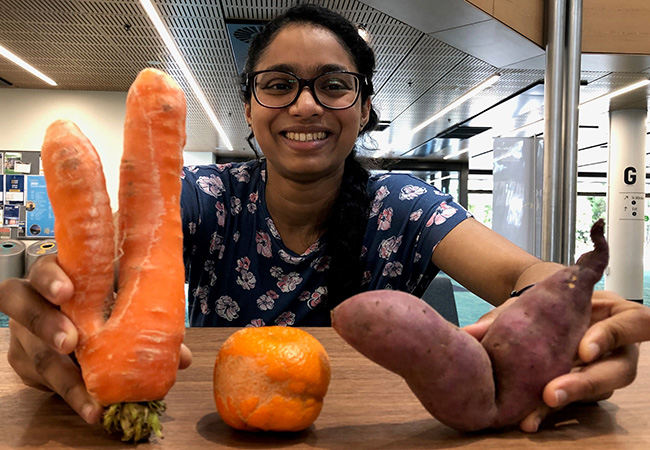Tuesday 12 November 2019 2:36pm

Department of Marketing PhD student Annesha Makhal with some wonky vegetables.
Bent, twisted and ugly fruit and veg, traditionally binned because they do not meet retailers’ cosmetic standards, could have a new market, University of Otago research suggests.
A new study, conducted by Department of Marketing PhD student Annesha Makhal, revealed children are more accepting than adults of suboptimal fruit and vegetables, offering retailers marketing opportunities.
Cosmetic standards are a major reason for almost 45% of fruit and vegetables being thrown away globally every year.
“The United Nations has a goal to halve food loss and waste by 2030, which like many other countries, New Zealand has also adopted,” Ms Makhal says.
“Meeting this goal means that we need to identify areas where food waste could be avoided. This is where my research comes in.”
Ninety-seven children, aged between 5 and 11, were provided with a shopping basket and shopping list requiring them to choose two quantities each of a fruit and vegetable, from a large assortment displayed on a table.
Produce that would normally not be sold due to suboptimal shape, colour and size were perceived as positive by the children.
Shape defects imparted a unique appearance which led the children to prefer the suboptimal options.
“I like it, I like how it’s bent because I like all sorts of carrots,” one 8-year-old boy commented, while an 11-year-old girl preferred the “ugly” carrot because “it’s different and it’s twisted”.
Personifying misshaped fruit led to positive taste inferences, with children choosing fruit because it resembled a “mini phone” and “alien”.
Ms Makhal says many of the children who had eaten ugly produce before could confirm it is perfectly edible and tasted great.
“We found that children find misshaped produce fun and interesting. One of the words used was ‘cute’ to describe produce with shape defects.
“This challenges the contemporary good appearance equals good quality norm,” she says.
Children were also willing to accept produce with colour defects, and size was only a matter of personal preferences with no clear majority indicating a preference.
Blemishes, however, were largely considered negative, with the participants associating “bruising”, “brown marks”, and “scars” to poor taste.
“In general, when looking back at the research that has been done with adults, we find that children are more accepting of ugly produce,” Ms Makhal says.
“Specifically, most children were willing to eat produce with shape, size, and colour defects. That means retailers can target produce with such cosmetic defects to children … and such fruit and vegetables can be saved from the landfills.
“The more consumers we can get to accept ugly produce, the more fruits and vegetables we can save from the landfills, which is a step closer to an environmentally sustainable food supply chain.”
The study recognises that as young consumers, children can play a vital part in saving “wonky produce”, she says.
“Traditionally the role of children has been downplayed, but their voices are now being increasingly heard. For example, the Fridays for Future campaign has brought about climate change activists in the younger demographic, who are now influencing many government bodies to seriously consider the climate emergency.
“Similarly, ours is just one study that suggests leveraging the power of children in the fight against food waste.”
For more information, contact:
Annesha Makhal
PhD researcher
Email annesha.makhal@postgrad.otago.ac.nz
Lea Jones
Communications Adviser (Otago Business School)
Tel +64 3 479 4969
Mob +64 21 279 4969
Email lea.jones@otago.ac.nz
